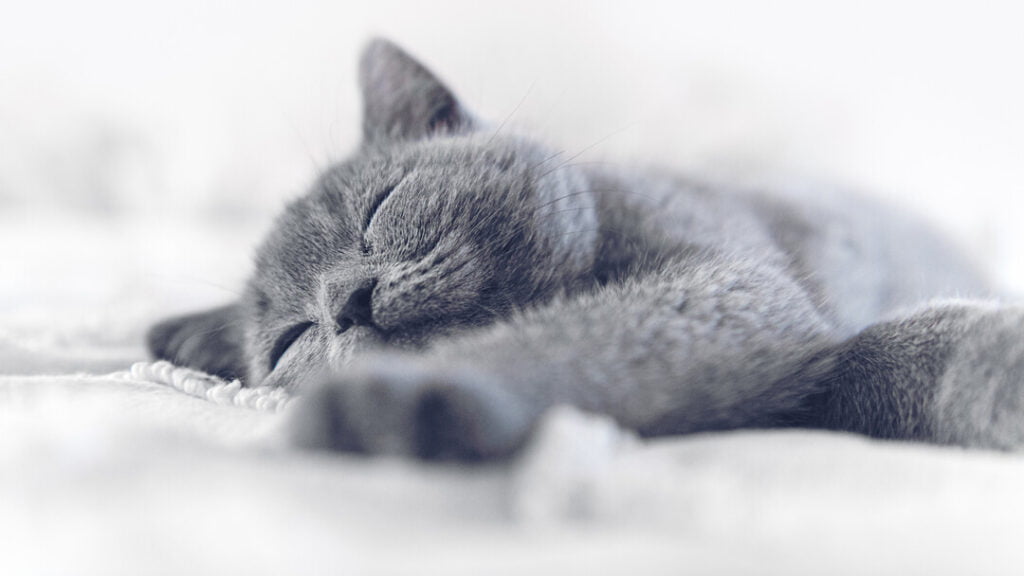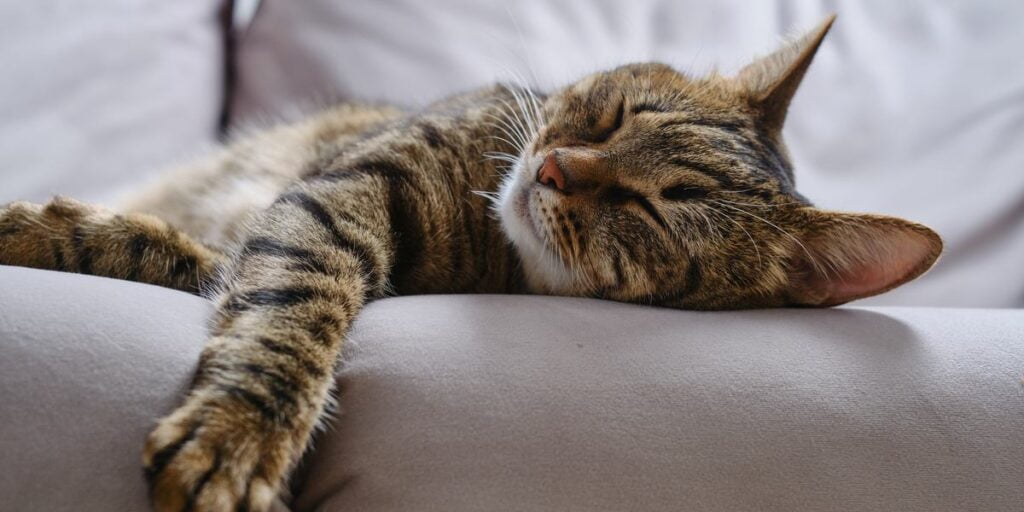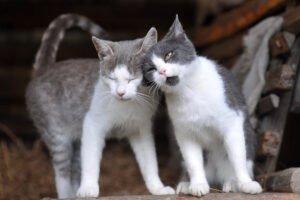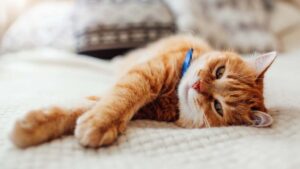The Truth About Cats’ Sleep: Do Cats Sleep at Night?

Cats have always been known for their long naps during the day and lazy lifestyle, which may lead you to the thought, “Do Cats Sleep at Night?”
Despite what it may seem, the truth is that cats do sleep at night, but their sleeping patterns are quite different from humans.
Cats are crepuscular animals, meaning they are most active during the dawn and dusk hours. This is because their natural hunting instincts have evolved to take advantage of the low light levels during these times. As a result, they tend to sleep during the day and are active at night.
In this article, we’ll take a closer look at a cat’s sleep pattern and explore how it differs from human sleep. We’ll also examine the factors that influence a cat’s sleeping habits and discuss how you can ensure your cat gets the rest they needs to stay healthy and happy.
Lastly, we will discuss how to (safely) encourage your cat to sleep at night and avoid nagging you while you sleep.
Understanding Sleep for Cats
If you are a cat owner, it is important to understand your pet’s sleep pattern to ensure they are getting the rest they need to maintain their health and well-being. While cats may seem to sleep all day, they have a unique sleep pattern that differs from humans.
Cats are known for their ability to sleep for long periods, with some sleeping for up to 16 hours a day. Unlike humans who sleep for long, continuous periods, cats sleep in short bursts throughout the day and night. This means they may appear to be sleeping at all hours, but in reality, they are just taking short naps.
Another important aspect of cat sleep is the amount of deep sleep they require. Cats need a significant amount of deep sleep to maintain their physical and mental health. During this deep sleep, their body undergoes necessary repair processes to maintain their muscles, organs, and immune system.
It is also important to note that certain factors can affect a cat’s sleep, such as their age, health, and environment. For example, older cats may require more sleep, while a stressful or noisy environment can disrupt their sleep pattern.

Sleep Patterns
Cats have a unique sleep pattern that differs from humans. While humans have a regular sleep cycle that lasts for several hours, cats’ sleep cycles are short and can last for about 15 minutes at a time. These sleep cycles allow cats to rest and conserve energy throughout the day and night, as they are crepuscular animals and tend to be more active at dawn and dusk.
During their periods of wakefulness, cats may engage in activities such as grooming, hunting, or exploring their environment. This pattern of sleep and wakefulness is essential for their survival in the wild, as they need to be alert and ready to hunt prey at any given time.
Sleep Duration
While cats are known to sleep frequently, the duration of their sleep can vary depending on different factors. As a general rule, cats sleep for an average of 12-16 hours per day, which is much more than humans. This long period of rest is essential for their overall health and well-being.
The amount of sleep a cat requires can vary based on their age, health, and activity level. Young kittens and elderly cats may require more sleep, while healthy adult cats may sleep less if they are active and stimulated during the day.
Cats can nap frequently throughout the day and night, which allows them to rest and recharge as needed. Cats’ instincts as hunters influence their sleep patterns, causing them to sleep more during the day to conserve energy for nighttime hunting activities.
Their sleep duration also depends on external factors, such as the seasons. Cats tend to sleep more in the summer due to the heat and attempt to conserve energy.

Sleeping Habits
Cats have various sleeping habits, and they often seek out comfortable and warm spots to doze off. They love to curl up in small spaces or stretch out on soft surfaces like a bed or a sofa. Cats may also change their sleeping position frequently throughout the day, from lying on their back to sleeping on their stomach or curled up in a ball.
It is interesting to note that cats also sleep in odd places and positions, such as on top of cabinets, in laundry baskets, or even in a cardboard box. This habit may be due to their instinct to seek out secure and hidden locations for sleeping, which can provide them with a sense of safety and comfort.
Moreover, cats are known to sleep for short periods throughout the day, which allows them to conserve energy while still being vigilant for potential prey or dangers. This pattern of sleep is essential for their survival, and it is also one reason why cats are considered excellent hunters.
Possible Sleep Disorders
Cats, like humans, can experience various sleep disorders that can disrupt their normal sleep patterns and impact their overall well-being.
Insomnia
Insomnia in cats is characterized by difficulty falling asleep or staying asleep, leading to restlessness and lethargy during the day.
It can be caused by various factors such as anxiety, medical conditions, or environmental disturbances. To address insomnia in cats, a veterinarian may recommend lifestyle modifications such as creating a quiet and comfortable sleeping environment, establishing a regular sleep routine, or providing calming supplements.
Sleep Apnea
Sleep apnea is another sleep disorder that can affect cats, causing brief interruptions in their breathing while they are asleep. This can result in reduced oxygen levels and disturbed sleep. The condition may be caused by anatomical abnormalities, obesity, or other underlying health issues.
A veterinarian can diagnose sleep apnea through observation and potentially recommend treatments such as weight management, positional therapy, or the use of continuous positive airway pressure (CPAP) devices.
Narcolepsy
Narcolepsy, although rare in cats, is a sleep disorder characterized by sudden and uncontrollable episodes of sleep. These episodes can be triggered by excitement or stress, and the cat may fall asleep suddenly and without warning. Narcoleptic episodes are typically short-lived and can be followed by periods of wakefulness.
A veterinarian can prescribe medications to help manage narcolepsy in cats and reduce the frequency and severity of these episodes.
How to get your Cat to sleep at Night?
Creating a Sleep-Friendly Environment
To ensure your cat gets the necessary rest, it’s important to create a sleep-friendly environment. This can include providing a comfortable bed in a quiet, dark space, and establishing a routine for bedtime.
Keeping your cat’s sleeping area clean and free from any potential disturbances, such as loud noises or bright lights, can also help promote a peaceful sleep.
If you have multiple cats, it’s important to provide each cat with their own sleeping space to avoid any potential territorial issues. Some cats may prefer to sleep alone, while others may enjoy sleeping near their owners. Pay attention to your cat’s preferences and adjust their sleeping environment accordingly.
Consistent Routine
Additionally, providing your cat with a consistent daily routine and ample physical activity can help promote better sleep. This can include playtime, interactive toys, and designated areas for scratching and climbing.
It’s important to establish a routine for feeding and litter box maintenance, as disruptions in these routines can lead to stress and disrupt your cat’s sleep pattern.
Avoid feeding them in the night (e.g. in the middle of the night) as this leads to the expectation of receiving food in the night. This is a dangerous pitfall you want to avoid at all costs.
Playtime before Bed
Another good strategy is to have an intense play session with your cat right before your bed time. This makes them tired (and sleepy) which promotes a habit of sleeping at night.
Conclusion
In conclusion, while cats do sleep at night, their sleep patterns differ from humans. Understanding a cat’s sleep habits is crucial for providing them with the necessary rest for their health and well-being. By creating a sleep-friendly environment and recognizing potential sleep disorders, you can ensure your feline companion gets the best sleep possible.


